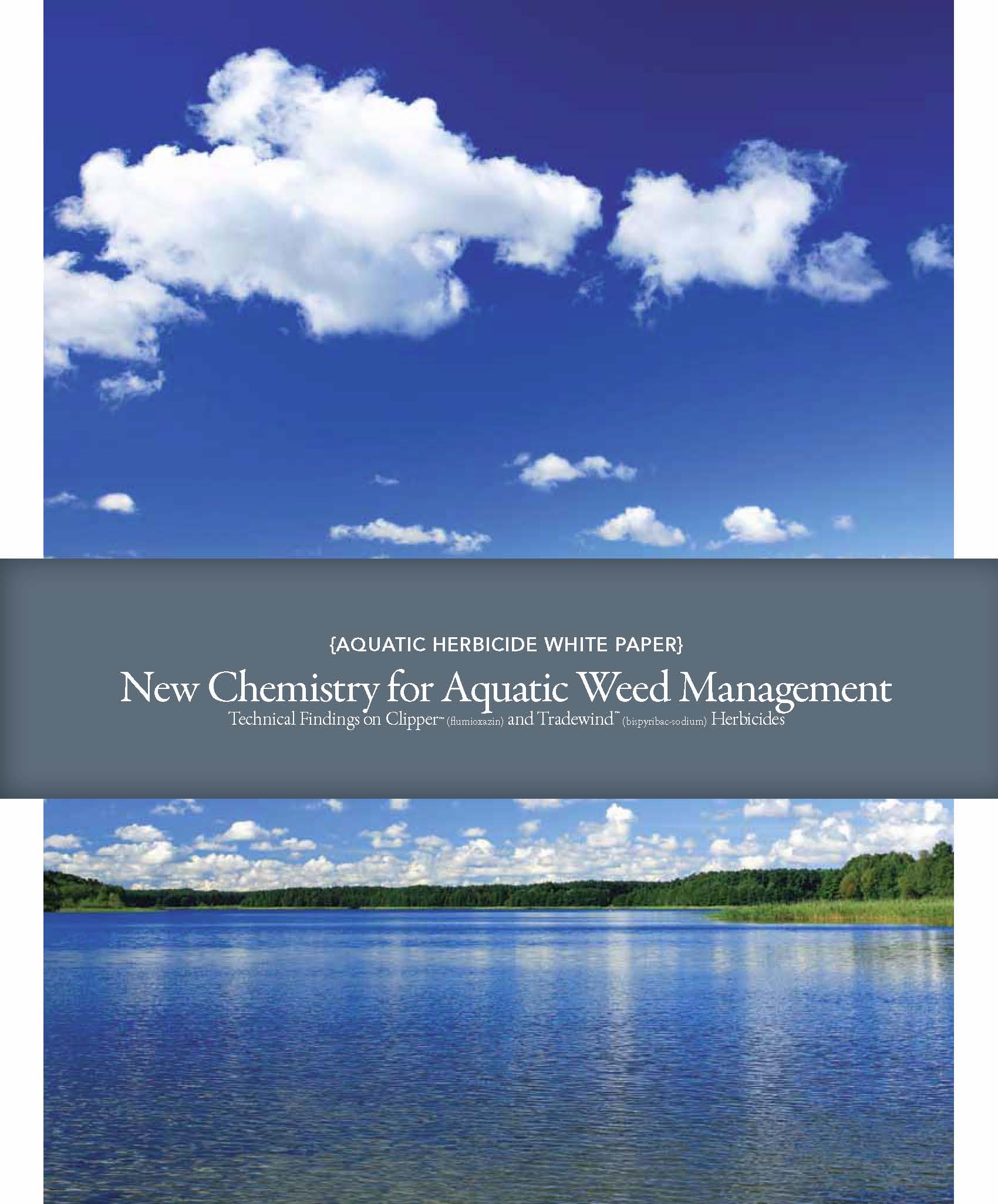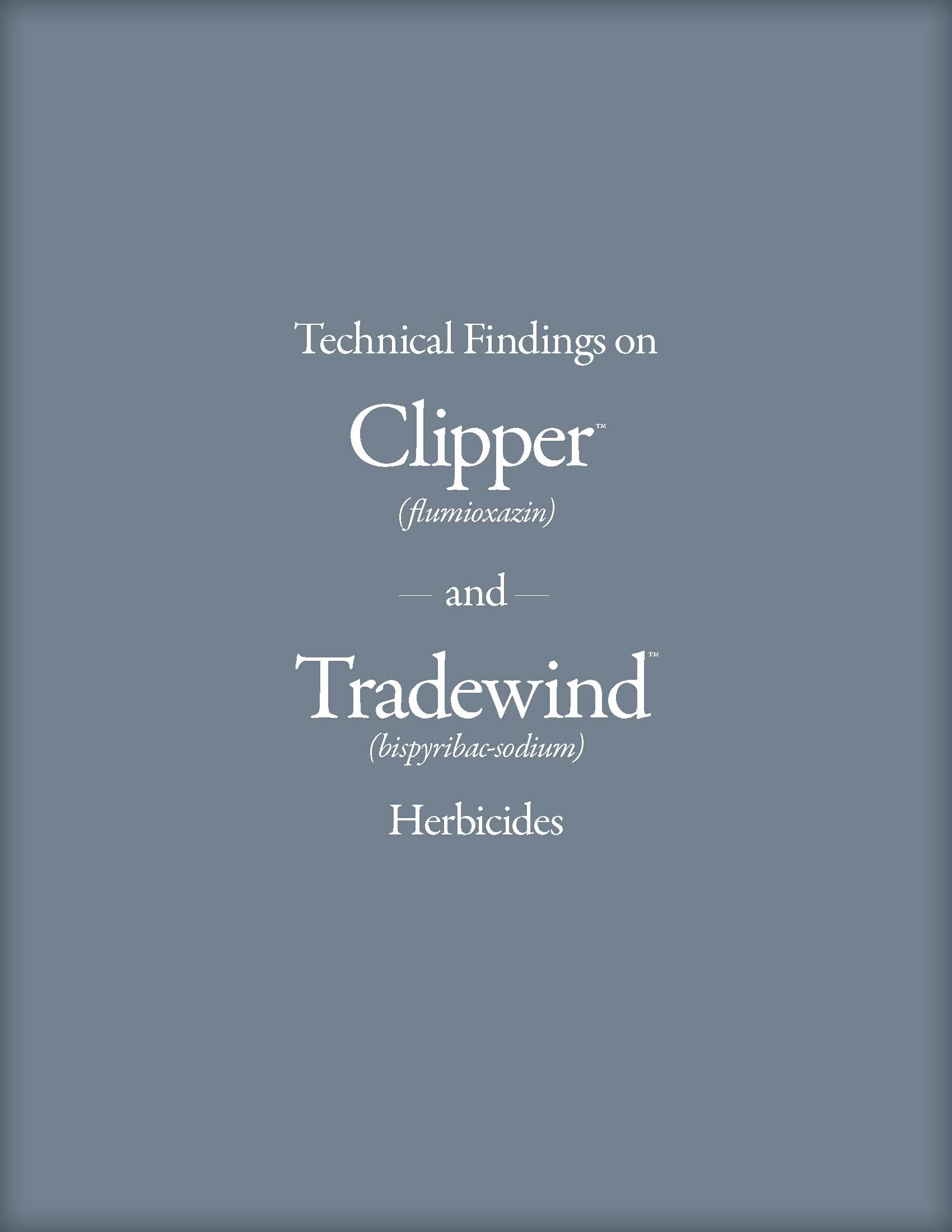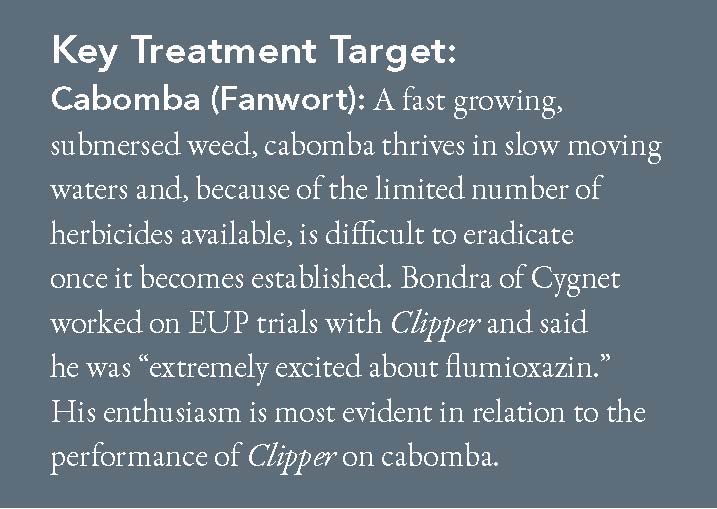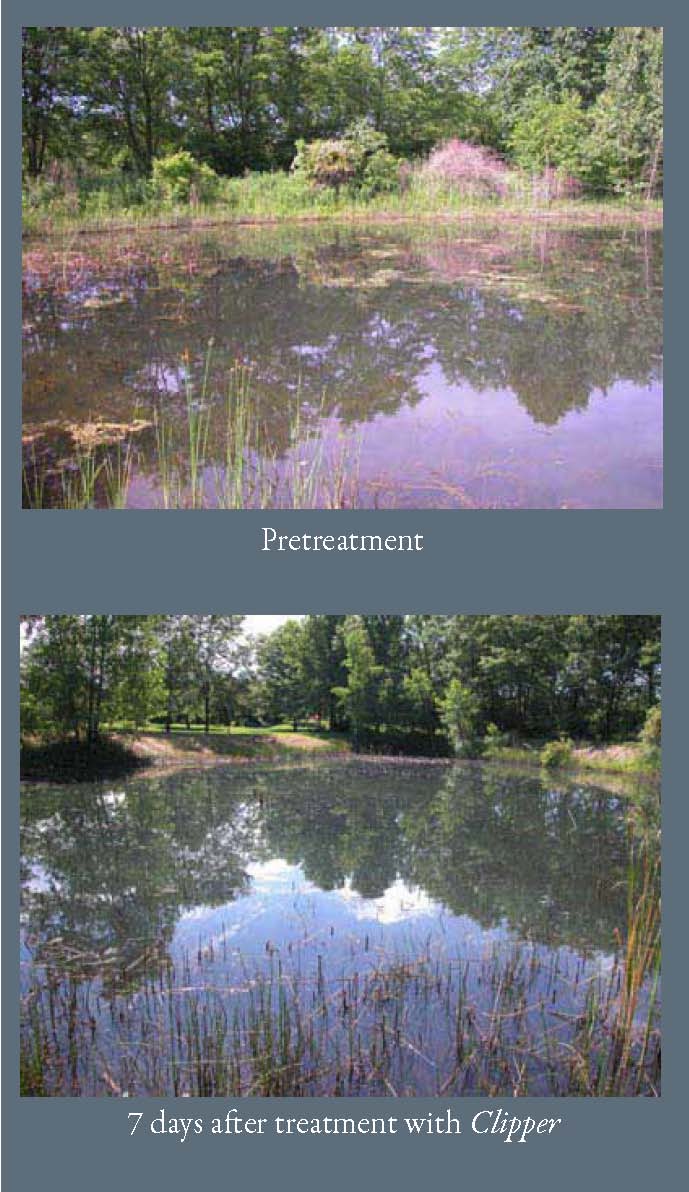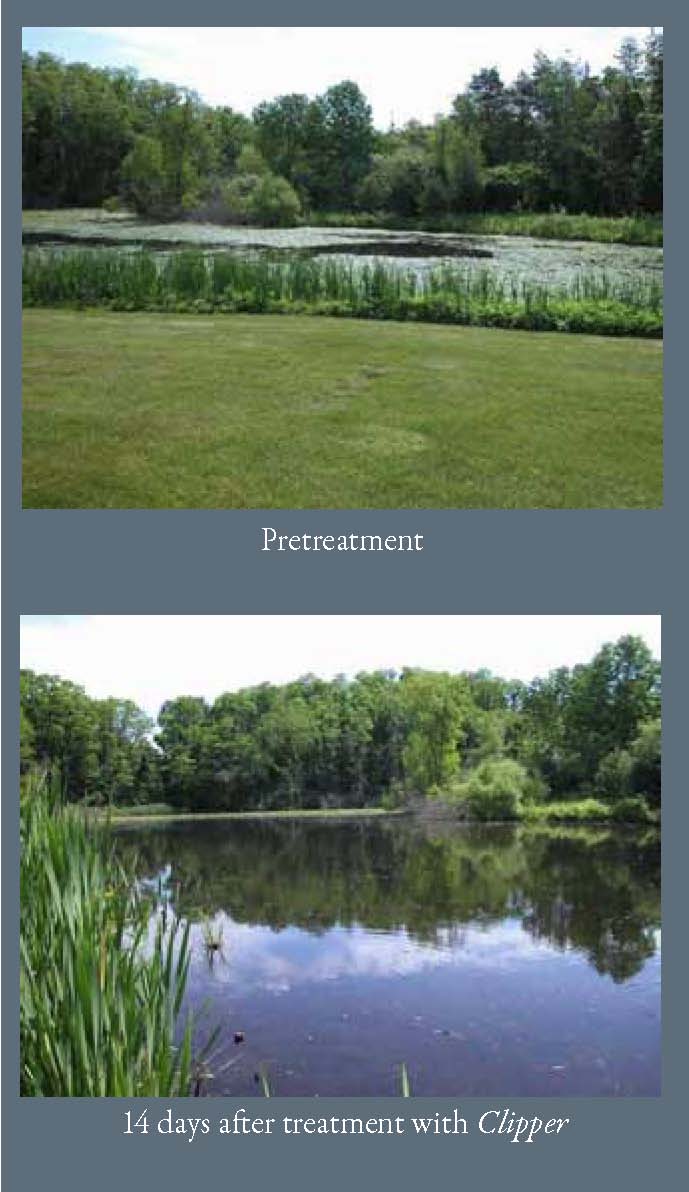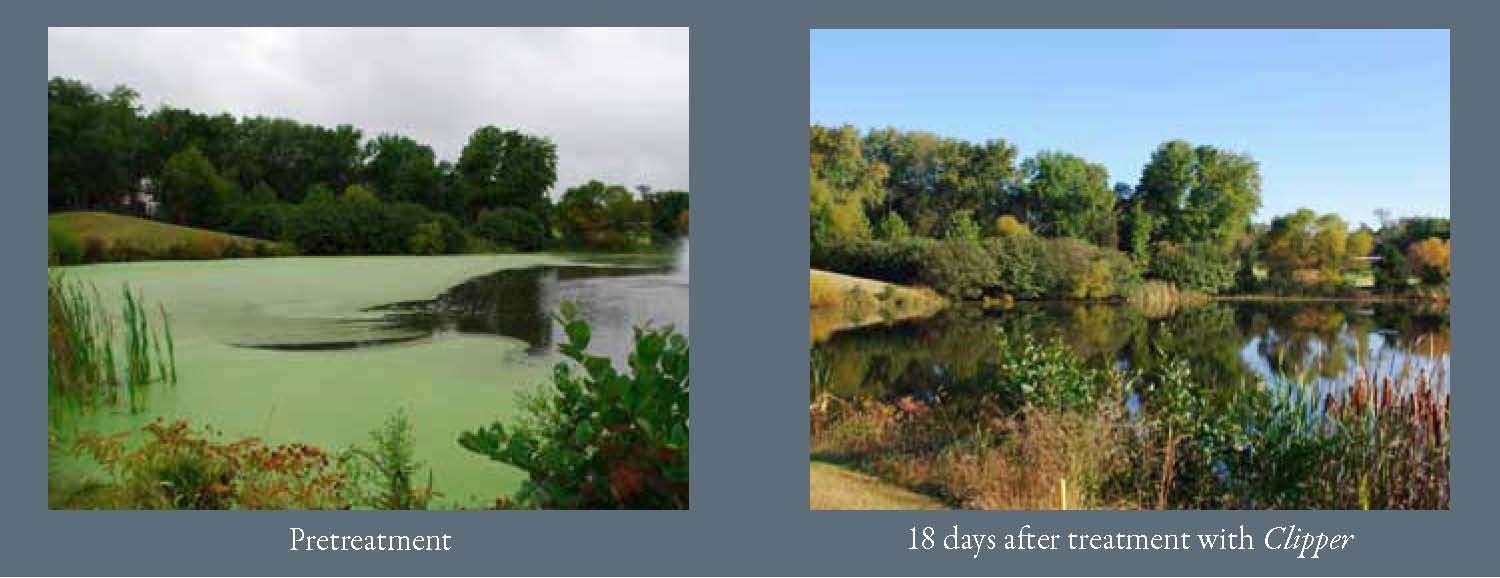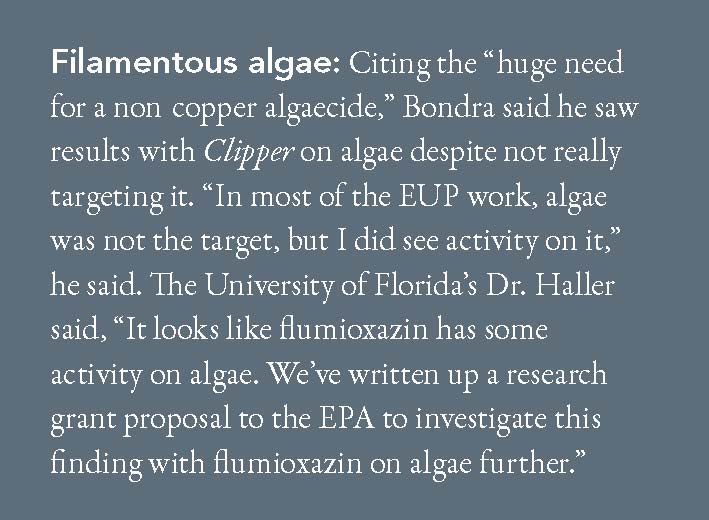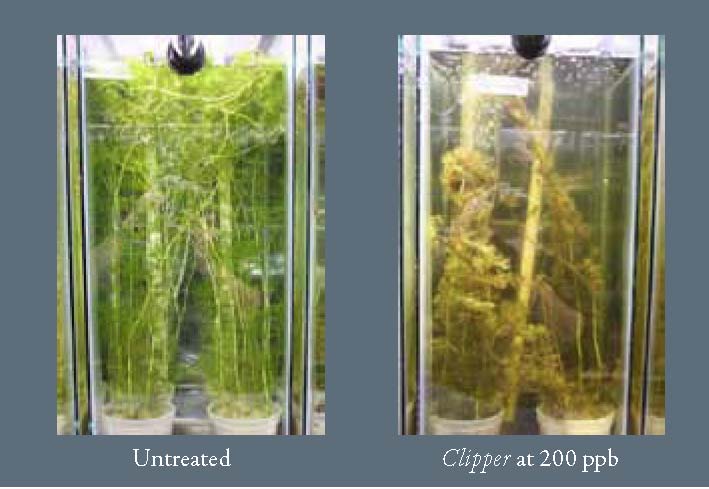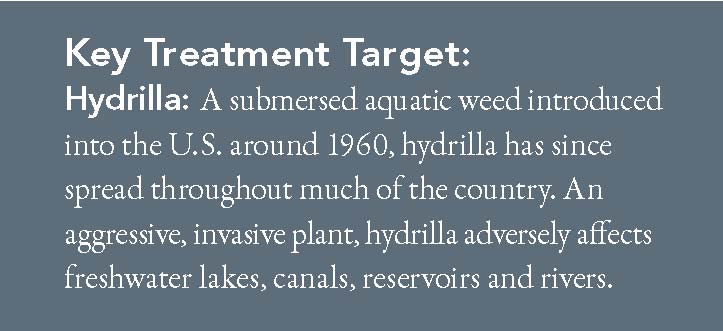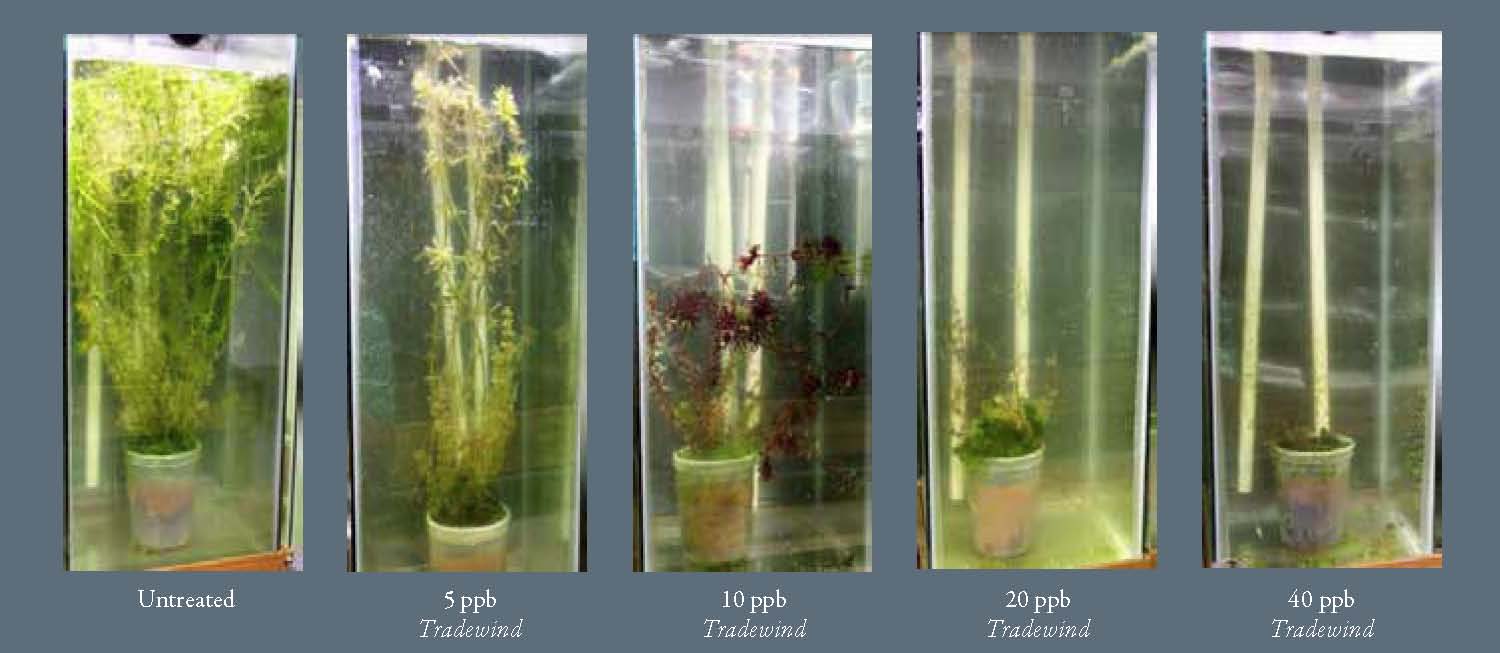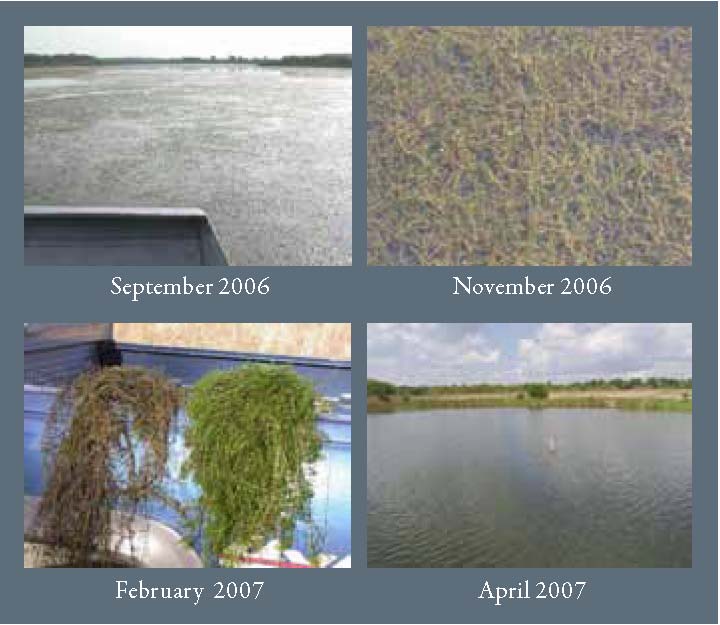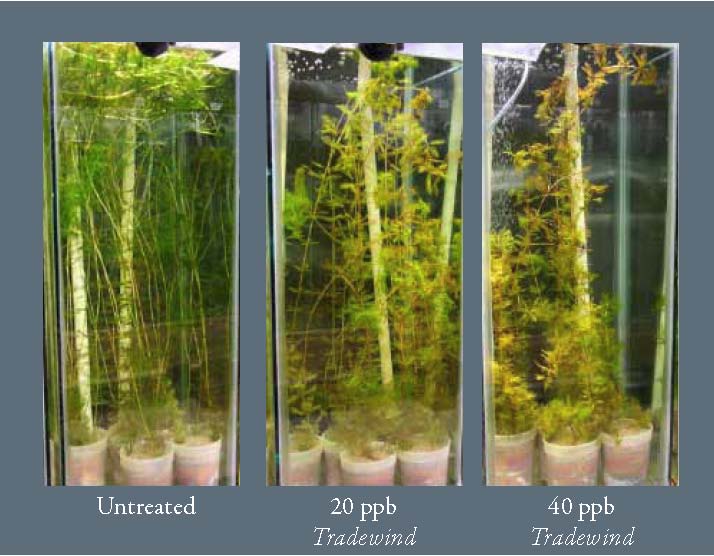Introduction
Invasive and nuisance aquatic plant species are a significant and increasing problem in water bodies throughout the United States. Invasive weeds such as hydrilla, cabomba (fanwort), Eurasian watermilfoil, water lettuce, water hyacinth and watermeal damage fish and wildlife habitats, blocking previously navigable areas, restricting recreation and decreasing property values. Nationwide, costs associated with the chemical and mechanical management of these weeds exceed $150 million per year in public funds,
1
according to a June 2008 article in Outlooks on Pest Management.
Valent Professional Products anticipates the launch of a new portfolio of aquatic products offering new solutions to help control aquatic weeds. These new products—Clipper™ Herbicide (flumioxazin) and Tradewind™ Herbicide (bispyribac-sodium)—upon EPA registration, are intended to provide aquatic plant managers with new treatment options at a time when herbicide resistance, variable response and environmental concern issues loom large.
Clipper and Tradewind have been evaluated under Federal Experimental Use Permits (EUPs) in various states, and this document cites some of the key findings from these studies.
CURRENT AQUATIC HERBICIDE SITUATION
As recently as 15 years ago, the number of aquatic herbicides available for use in U.S. waters was extremely limited. To control hydrilla, aquatic plant managers used diquat, endothall and fluridone. For filamentous algae, copper was the product of choice. “In 1995 we had six products registered for aquatic use and we were pretty happy,” said Dr. Bill Haller, director of the University of Florida’s Center for Aquatic and Invasive Plants. In those days, Dr. Haller said, fluridone could be expected to control hydrilla, a submersed weed, for one or even two years. Magnacide (acrolein) was used liberally to clear agricultural irrigation canals of unwanted weeds, but Dr. Haller said there were environmental concerns associated with this product. ven
active ingredients
for aquatics.”
Joe Bondra, vice president and general manager,
Cygnet Enterprises, Inc.
“For the longest time we only had six or seven active ingredients for aquatics,” said Joe Bondra, vice president and general manager of Cygnet Enterprises, Inc., the largest single-source distributor of aquatic management products in the country. “Until recently, there hadn’t been many new tools in the toolbox for the lake manager to pick from.”
As environmental concerns increased and resistance issues emerged, a market for new herbicides with different modes of action developed and continues to grow. The state of Florida alone, Dr. Haller said, is now spending $25 million per year on aquatic weed control.
“I’ve been in aquatic plant management over 20 years and have really seen the market expand in the last 10 years,” said Chip Davis of Santee Cooper’s Analytical & Biological Services Division in South Carolina. “There’s always room for more products in terms of selectivity. We’re at the point now where we’ve got selective control. We can take out the undesirable weeds but still keep the desirable plant species, which is especially important in some of our habitat enhancement projects.”
However, aquatic resource managers do not have control over all invasive plant species. “Despite public programs for containment and prevention of the spread of aquatic weeds, the exotic submersed species hydrilla has spread from Florida to Maine on the East Coast, across the Gulf Coast states, and to California and Washington on the West Coast,” according to the aforementioned 2008 Outlooks on Pest Management article.
An article in the 2008 edition of the Journal of Aquatic Plant Management advises readers that “the invasive exotic plants hydrilla and Eurasian watermilfoil continue to spread and remain the plant species of greatest concern for aquatic resource managers at the national scale.2”
The difficulty in controlling these weeds, and the increasing resistance of some species, underscores the need for a continual flow of products with new modes of action into the marketplace. “Having different modes of action is important for lake managers,” Bondra said. “Agriculture has rotated treatments for decades, due in part to the limited number of choices available. We have not rotated in aquatics. Now that there will be more products with different modes of action and active ingredients, the aquatic manager will have the flexibility to rotate products as deemed appropriate.”
CLIPPER HERBICIDE (FLUMIOXAZIN) Registration Anticipated: Q4 2010
A contact herbicide, the active ingredient in Clipper, flumioxazin, has demonstrated in research trials fast-acting control of aquatic weeds such as cabomba, watermeal, water lettuce, duckweed and, as part of a tank mix, hydrilla. Clipper, which worked best during the early-growth stage of most weeds, also has shown promise for control of some species of algae. Because studies show Clipper dissipated quickly from the water column and did not accumulate in the sediment, Valent Professional Products research and development manager Mike Riffle said it is less of an environmental concern than other, more persistent herbicides. Studies have also shown that Clipper can be applied to control floating or submersed weeds, providing flexibility to applicators.
Besides providing aquatic resource managers with a new mode of action, Clipper also has low use rates of 6 to 12 ounces of product per surface acre on floating and emergent weeds and 100 to 400 parts per billion (ppb) on submersed weeds, according to Riffle.
“We know from the EUP work that Clipper has great efficacy on cabomba,” Bondra said. “Some applicators have told me you can run over cabomba with a truck and still not kill it.”
“There is a real need for a predictable cabomba treatment,” he added. “Clipper on cabomba was, in a word, awesome. The EUP trials seemed to indicate that flumioxazin didn’t need as much contact time [as other products].”
Indiana EUP trial
Conducted by Cygnet Enterprises, Inc.
Target weed: Cabomba
Rate: 200 ppb
Indiana EUP trial
Conducted by Cygnet Enterprises, Inc.
Target weed: Cabomba
Rate: 200 ppb, Water pH: 7.8 to 8.0
Davis, meanwhile, said that “we have had a big problem with cabomba in our lake system over the years with limited success in controlling it. Flumioxazin consistently gave us excellent control in the EUP trials.”
In treating an 11-acre canal at Old Santee Canal Park that was “pretty much 100% cabomba and basically impassable for canoeists, prior to the trial,” Davis said “it was amazing the results realized [with Clipper].” Applied in late July 2008 at a rate of 200 ppb, Clipper provided 100% control of cabomba—as well as duckweed and watermeal—within three weeks of a subsurface application. By fall, Davis said, “it was absolutely perfect for the remainder of the year.”
In mid-September 2008, Davis treated a 20-acre section of a 150-acre impoundment on Lake Marion with Clipper and said it “completely removed the cabomba from the treatment site.” The early assessment in 2009 was that there was still no cabomba present. “It selectively controlled the cabomba very quickly with control extending, so far, into this year,” Davis said.
Kevin Tucker, owner and president of Virginia Lake Management Co., has been a cooperator in multiple EUP trials in each of the last two years. In 2008, at a concentration of 200 ppb, Tucker applied Clipper to a pair of small ponds that were nearly 100% contaminated with watermeal.
In one pond, Tucker said, “all the watermeal was gone within a few days to a week, and we never saw it again.” In the other pond, he added, the majority of the watermeal was gone within a week. After some apparent regrowth of watermeal, a second treatment wiped it out.
In all, Tucker treated eight ponds with Clipper and saw good control in all eight upon the initial application. Only once was Tucker forced to make a second application, and he said that was because of new plant material flowing in rather than previously treated plants coming back.
Virginia EUP trial
Conducted by Virginia Lake Management Co.
Target weed: Watermeal, Rate: 200 ppb
“It looks like a miracle product for watermeal from what I’ve seen,” Tucker said.
Tucker added that Clipper “seemed to take out the watermeal and leave the desirable native plants behind.”
Surface applications of Clipper resulted in “great activity” on watermeal, according to Bondra. Watermeal can be problematic in lakes, ponds and reservoirs across the United States.
“I assisted with some of the plots myself and saw with my own eyes,” Bondra said. “Watermeal is a huge problem and it’s hard to kill, but we saw great activity with flumioxazin. Typically, watermeal treatment results with other products can be very inconsistent. In my opinion, we have never really had a good go-to option to control watermeal each and every time.” Bondra also saw activity on sago pondweed, a plague of irrigation canals in several Western states.
EUP Trial Results—Watermeal
| Trial Location | Applicator | App. Method | App. Rate | Target Weed | Results |
|---|---|---|---|---|---|
| Virginia Beach, Va. | Kevin Tucker | Sub-surface | 400 ppb | Watermeal | 100% covered at application. Less than 1% coverage within three weeks of application. |
| Virginia Beach, Va. | Kevin Tucker | Sub-surface | 200 ppb | Watermeal | 100% covered at application. Less than 1% coverage within three weeks of application. |
Target Weed: Eurasian Watermilfoil
Rate: 200 ppb
Riffle said, “There is some evidence that Clipper has controlled filamentous algae in certain cases. That’s important because right now there are very few alternatives to copper, which is under a bit of fire right now due to environmental fate issues.”
Other invasive weeds: While Bondra said Clipper is probably best used as a tank mix with diquat to combat hydrilla, he said there’s no need to mix Clipper in order to deal with Eurasian watermilfoil. Difficult to remove once it becomes established, Eurasian watermilfoil can be treated with contact herbicides like Clipper upon product registration.
“It had great activity on Eurasian watermilfoil,” Bondra said of Clipper. “That was one of the most exciting things about it—it worked very quickly and didn’t stay around long.” That’s particularly important, Bondra added, since milfoil seems to be starting to show some variable response issues to granular 2,4-D treatments, forcing aquatic managers to apply 2,4-D at the higher labeled rates.
Tests performed by third-party research groups in association with the Aquatic Ecosystem Restoration Foundation (AERF), such as the U.S. Army Engineer Research and Development Center (ERDC) in Vicksburg, Miss., found that Clipper can provide an alternate mode of action for controlling giant salvinia. Studies also indicated that Clipper is efficacious against giant salvinia via broadcast and subsurface application techniques, providing acceptable plant control.
The addition of another effective product, along with glyphosate and diquat, would diversify the choice of chemical strategies for giant salvinia management and play an important role in resistance management.
Research also showed Clipper was effective against hydrilla when used as a tank mix with other herbicides. A mixture of Clipper and diquat, in particular, showed promise against hydrilla, one of the more problematic invasive weeds for aquatic managers to deal with today. When mixed at use rates of 100 ppb (Clipper) and 375 ppb (diquat) at five hours of exposure, Clipper and diquat provided 81% control of hydrilla, according to a third-party mesocosm study conducted in association with the University of Florida’s Center for Aquatic and Invasive Plants. With 20 hours of exposure, control increased to 90%.
“Clipper and diquat together did a good job as a contact herbicide on hydrilla,” Riffle said. “Because of the resistance issues with fluridone, it is important to have alternatives, and this appears to be one.”
TRADEWIND HERBICIDE(BISPYRIBAC-SODIUM) Registration Anticipated: Q1 2011
A systemic herbicide with long-lasting residual control, the active ingredient in Tradewind, bispyribac-sodium, is an acetolactate synthase (ALS)–inhibiting herbicide that in research trials exhibited control of floating and submersed aquatic weeds. Because Tradewind was mostly stable in the water column, studies point toward an excellent toxicology profile with minimal impact on native plant species.
Based on EUP field, mesocosm and chamber observations, Tradewind provided excellent control of hydrilla.
According to a joint study by the University of Florida’s Center for Aquatic and Invasive Plants and the U.S. Army Engineer Research and Development Center, Tradewind applied at a concentration of 20 ppb and with eight or more weeks of exposure resulted in greater than 90% biomass reduction and growth inhibition in both hydrilla and Eurasian watermilfoil in growth chamber studies.3
A separate report by researchers at the Center for Aquatic and Invasive Plants on the efficacy of Tradewind on hydrilla in ponds, meanwhile, determined that “a single application of 45 ppb bispyribac-sodium will provide one year of hydrilla control depending upon the time of year in which the herbicide is applied.”4
“You can get six to 12 months of control of hydrilla consistently with bispyribac,” Dr. Haller said. “I think bispyribac is as good as or better than other ALS-inhibitors. We want to kill hydrilla; we don’t want to kill any native species. Bispyribac has advantages in terms of selectivity.”
Dr. Haller said Tradewind was “safe” with regard to non-target aquatic plants such as maidencane, Kissimmee grass and sagittaria plants based on EC50 (?g/L) values. Additionally, Dr. Haller said, Tradewind had “greater selectivity than [fellow ALS-inhibitor] penoxsulam on sagittaria.” When tested at 27 ppb at Florida’s Sand Mine Lake, Dr. Haller said, Tradewind did not adversely affect cattail or coontail.
Target Weed: Hydrilla, 16 Weeks after Treatment
University of Florida EUP trial
Sand Mine Lake, Eustis, FL
Target Weed: Hydrilla, Rate: 27 ppb
In other studies, Dr. Haller said, Tradewind had no adverse impact on southern naiad when applied at 50 ppb or on Vallisneria americana (wild celery) at 100 ppb.
Other invasive weeds: Tradewind showed promise against a number of aquatic weeds in addition to hydrilla. According to EUP field, mesocosm and chamber observations performed by third-party research groups, Tradewind provided good-to-excellent (70% or better) control of such troublesome weeds as Eurasian watermilfoil, sago pondweed, water hyacinth and water lettuce when applied as a submersed treatment. As a foliar application, Tradewind provided excellent (85% or better) control of water hyacinth and water lettuce.
Also according to tests conducted by third-party researchers, Tradewind-treated plants displayed visual herbicide symptoms within two weeks of treatment.
Target Weed: Eurasian Watermilfoil
2 Weeks after Treatment
CONCLUSION
Providing aquatic resource managers with new tools in the fight against invasive weeds, Clipper and Tradewind are complementary products that can be used as combination partners or in rotation with other products. By bringing new treatment options to an industry in need of them, Clipper and Tradewind will also help the increasingly important battle against resistance and, hopefully, help reclaim more of the nation’s waters and wetlands from noxious, invasive weeds.
Disclaimer
Some of the data presented in this technical guide are from results of studies conducted by the U.S. Army Engineer Research and Development Center (ERDC), under a Cooperative Agreement with the Aquatic Ecosystem Restoration Foundation. Citation of trade names does not constitute an official endorsement or approval of the use of such products by the ERDC.
Footnotes
1) Parochetti, James; Arsenovic, Marija; Getsinger, Kurt D.; Stubbs, Donald; and Haller, William T. “Addressing the
Need for Herbicides for Aquatic Weeds in Irrigation Waters in the U.S.,” Outlooks on Pest Management, June 2008,
19(3):112-16
2) Getsinger, Kurt D.; Netherland, M.D.; Grue, C.E.; and Koschnick, T.J. “Improvements in the Use of Aquatic
Herbicides and Establishment of Future Research Directions,” Journal of Aquatic Plant Management, January 2008,
46:32-41.
3) Slade, Jeremy G.; Poovey, A.G.; and Getsinger, K.D. “Bispyribac-sodium 80 SP: Emerging Herbicide for Aquatic Plant
Management.” 2008 Florida Aquatic Plant Management Society Annual Meeting. Abstract.
4) Berger, Sarah; Haller, William T.; and Puri, Atul. “Valent Herbicides Evaluation for Activity on Hydrilla: Pond
Efficacy Results,” July 2008.

Products That Work, From People Who Care® | www.valentpro.com | 800-89-VALENT (898-2536)
Read and follow the label instructions before using.
Clipper and Tradewind are pending U.S. EPA registration and are not currently available for sale. Please check with your state to verify registration status. Clipper and Tradewind are trademarks and Products That Work, From People Who Care is a registered trademark of Valent U.S.A. Corporation. ©2010 Valent U.S.A. Corporation. All rights reserved. Printed in the U.S.A. 2010-Aquaticswhitepaper
